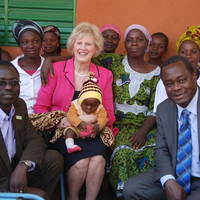

News
Dr. Dambia and Jhpiego Drive Heath Interventions

One morning in Pabre, a village about 15 miles from Ouagadougou, the capital of Burkina Faso, a small country in West Africa, more than 100 women waited anxiously for a white minibus. On the bus were nurses and midwives ready to screen and treat for cervical cancer. On the bus as well was an examination table, a nitrous oxide gas tank and medical supplies. For most women, it was an introduction to cancer screening; for many, their first access to medical care.
How the clinic on wheels came to be in a remote part of Africa represents the mission of Baltimore-based Jhpiego. A global health provider and technical assistance agency in more than 50 countries, Jhpiego develops low-cost solutions – like the cervical cancer screening method relying on simple vinegar and delivered in a specially equipped mobile van – to address complex health problems. Working with governments, NGOs, foundations and corporations, Jhpiego strengthens health systems by improving health care delivery services. It focuses on maternal, newborn and child health, HIV/AIDS, infection prevention, malaria, tuberculosis, as well as support to health care providers and community education. Through its work, Jhpiego provided care and treatment in 2016 to more than 13 million people worldwide.
Far from Pabre, in the United States, the Pap test – with specialized instruments and lab testing – is the gold standard for detecting cervical cancer, preventable through early detection and treatment but fatal if undiagnosed. By contrast, in developing countries such as Burkina Faso, there are few labs, even fewer costly instruments and little time to wait for test results. The accessibility gap is one of many public health factors that drive the work of Jhpiego and Alain Damiba, M.D., its energetic senior vice president of technical leadership and global programs.
“When we wake up, our focus is to figure out a way to get high-impact interventions to people with low resources in developing countries,” says Damiba. For example, seeking an alternative way to diagnose cervical cancer – which strikes 270,000 women annually, 90 percent in developing countries – Jhpiego worked with the local government and community leaders, Damiba explains, to develop a single visit approach like that in Pabre: during one visit, a patient would receive a visual exam of the cervix, followed by treatment of any precancerous lesions using a cryotherapy machine that does not require plugging into a power source. “This is critical because in a country of 20 million, we know that approximately 20 percent are women between 15 and 49, putting four million women at risk for cervical cancer.”